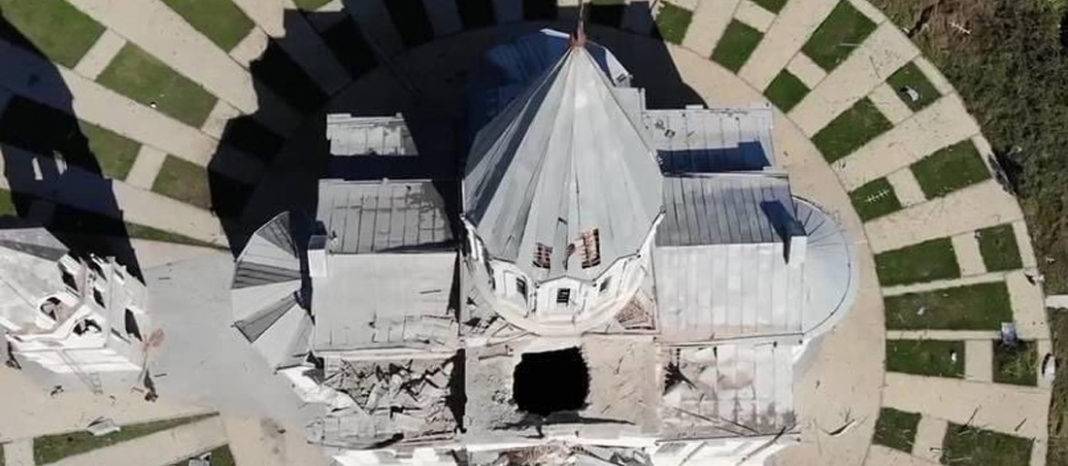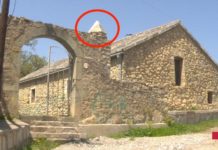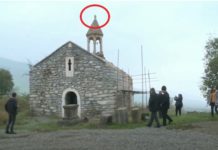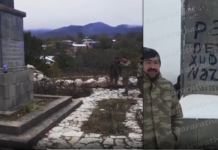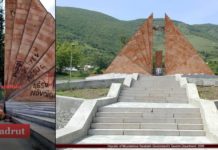Starting from the early morning of 27 September, 2020 Azerbaijan began launching indiscriminate airstrikes
(including UAV strikes) and artillery assaults against the Republic of Artsakh (Republic of Nagorno-Karabakh)
along the entire line of the border.
Villages, towns and the capital Stepanakert have been intensively attacked, which caused numerous casualties
and wounds among civilians. As of 20 October 2020, 37 civilians were killed, including children, women, and
persons with disabilities. Large-scale damages have been caused to civilian objects, such as residential buildings,
schools, etc. as well as infrastructure vital to the survival of the civilian population. The life and health of children,
women, and the entire population of Artsakh are still under an imminent and real threat.
During this aggression, Azerbaijan is also intentionally targeting the cultural and religious heritage of
Armenians in Artsakh. This is a part of the cleansing of ethnic Armenians living in Artsakh.
On 8 October 2020, Azerbaijani armed forces launched two intentional assaults on Holy Savior Ghazanchetsots
Cathedral of Artsakh in the town of Shushi, which is the recognizable cultural and religious symbol of Artsakh.
The Azerbaijani forces struck the cathedral two times within a few hours with the use of striking and manageable
drones. This act of Azerbaijan is in line with its continued practice of destroying the Armenian cultural heritage of
Artsakh. It also demonstrates radical disrespect towards the Christian element of Armenian identity.
The current report presents the facts on targeted attacks on the St. Holy Savior Ghazanchetsots
Cathedral, analyzing it in the context of the International Humanitarian Law and International
Criminal Law.
For the purpose of preparation of the report fact-finding missions, as well as monitoring of the official
and media publications were conducted.
St. Holy Savior Ghazanchetsots Cathedral is located on Ghazanchetsots Street, in the downtown of
Shushi, densely populated the second largest city of Artsakh. It was built in the 19th by the local
Armenians. The architect was Simon Ter- Hakobyan.
The Cathedral is considered to be the second most important spiritual center of ethnic Armenians
in Artsakh, after the monastery of Gandzasar. It is the center of the diocese of Artsakh of the Armenian
Apostolic church.
The architectural complex consists of a Church, which was built in 1868-1887, and a bell tower of
1858.
Figure 1: St. Holy Savior Ghazanchetsots Cathedral before the attacks

Figure 2: St. Holy Savior Ghazanchetsots Cathedral before the attacks
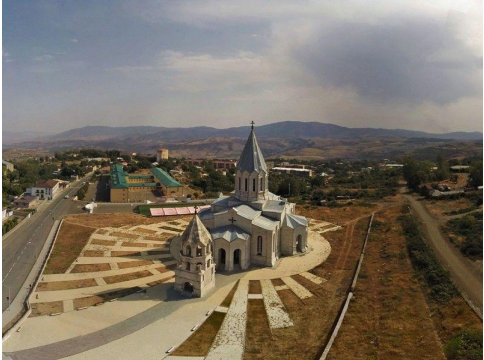
During the Nagorno-Karabakh war at the end of the 20th century, while being occupied, the St. Holy
Savior Ghazanchetsots Cathedral was used by Azerbaijan as storage for weapons.
Figure 3: St. Holy Savior Ghazanchetsots Cathedralduring the Nagorno-Karabakh war, used as a storage for ammunition by Azerbaijan

Before that, approximately in 1920, the Cathedral was used by the Azerbaijani people as a garage and
cattle barn. Later on, in that period the dome of the church was damaged.
Figures 4 and 5: The damaged dome of the St. Holy Savior Ghazanchetsots Cathedral
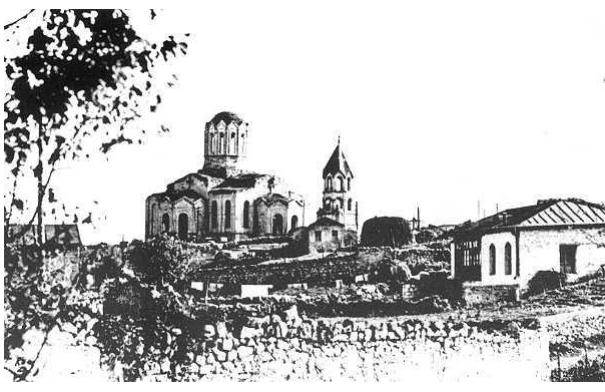
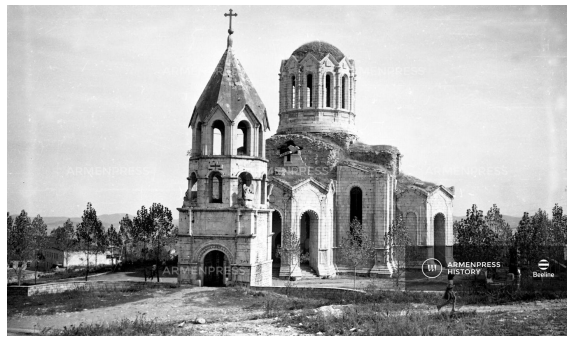
The Cathedral, including its dome and the surrounding area, was reconstructed in 1998 by the ethnic
Armenians of Artsakh.
The importance of the St. Holy Savior Ghazanchetsots Cathedral was emphasized also on 16 October,
2008, when more than 500 couples got married there.
Figure 6: The marriage of more than 500 Armenian couples at the St. Holy Savior Ghazanchetsots Cathedral
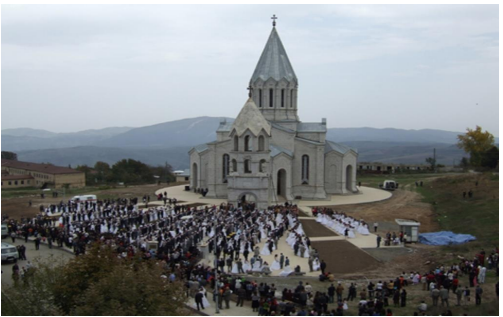
As it was already mentioned, the St. Holy Savior Ghazanchetsots Cathedral is located in the center of
the town Shushi, in the Republic of Artsakh (Nagorno Karabakh). As it is foreseen from the map below, the church is surrounded by civilian objects, residential buildings and there are no military objects near the Cathedral. In the same town, there are also 2 mosques.
Figure 7: Map illustrating the location of the St. Holy Savior Ghazanchetsots Cathedral and the two mosques located in the northeast of the Cathedral

On October 8, the Azerbaijani armed forces intentionally targeted the St. Holy Savior Ghazanchetsots Cathedral twice. The first missile attack was reported at around 13:00. According to the witnesses, the civilians living around, the first strike was made by the military plane. At that moment there were only children, women, and the elderly in the basement of the Cathedral. Moreover, the witnesses confirmed that the Azerbaijani military forces conducted targeted military attacks on the residential buildings in Shushi. And due to that reason, they had sought shelter from the targeted strikes in the basement of the Cathedral. Further, it was also noted that the Azerbaijani strikes were so extensive that there was no place for shelter in other basements, and that was the reason why they had sheltered in the basement of the Cathedral.
Figure 8: Women and children in the basement of the St. Holy Savior Ghazanchetsots Cathedral
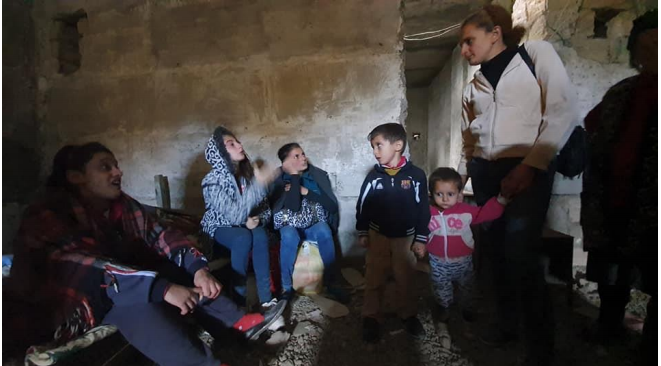
Figure 9: Burning St. Holy Savior Ghazanchetsots Cathedral
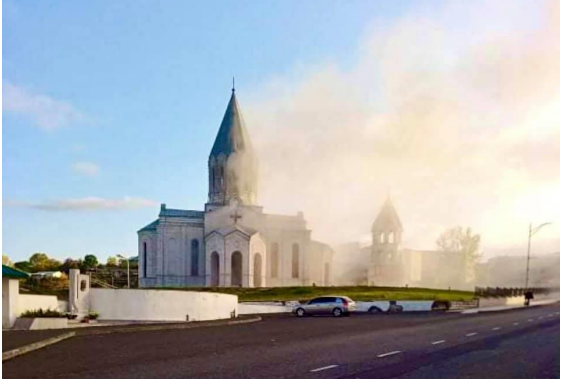
As a result of the attack, the southern dome of the Cathedral was seriously damaged.
Figure 10: The damaged roof of the St. Holy Savior Ghazanchetsots Cathedral from outside
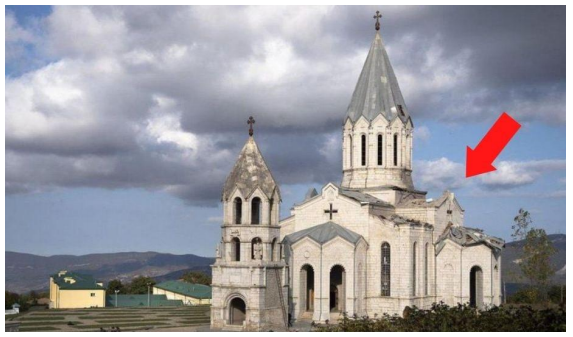
Figure 11: The damaged roof of the St. Holy Savior Ghazanchetsots Cathedral from inside after the first strike
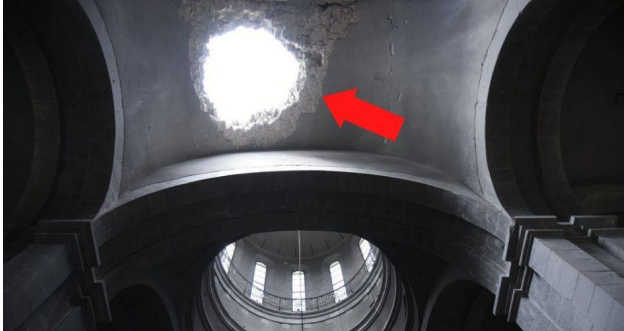
Figure 12: The destructions of the St. Holy Savior Ghazanchetsots Cathedral
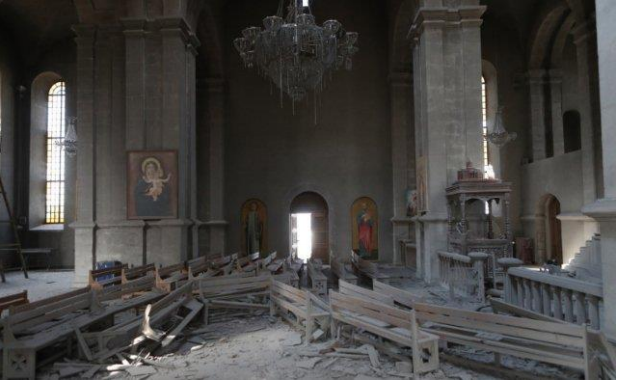
Figure 13: The destructions of the St. Holy Savior Ghazanchetsots Cathedral

Figure 14: The destructions of the St. Holy Savior Ghazanchetsots Cathedral
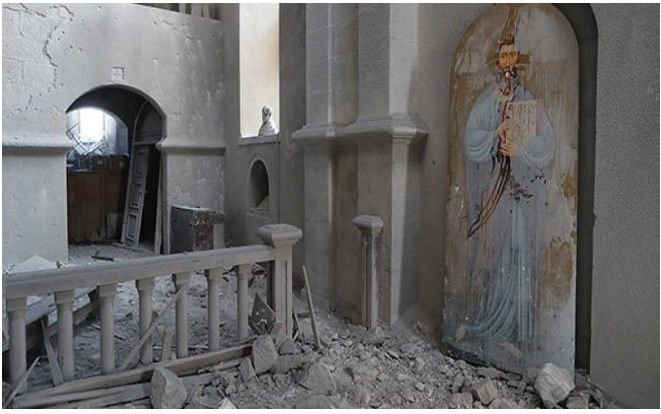
Right after the first attack, a group of foreign (Russian) and local journalists went to the St. Holy Savior Ghazanchetsots Cathedral both to report and publish the findings, as well as to help the peaceful population there. However, after a short break, around 16:30 the second airstrike was delivered by a striking unmanned aerial vehicle (UAV) on the same part of the Cathedral. A number of children, women, and the elderly were not able to leave. As a result, also huge destruction was caused to the building.
Figure 15: The damaged roof of the St. Holy Savior Ghazanchetsots Cathedral from inside after the second strike
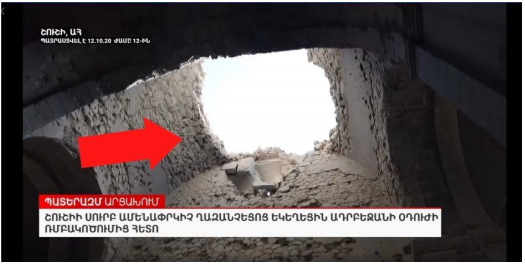
The three Russian journalists, who were in the Cathedral, were injured as a result of the air attack. 4 hours after the first attack the Azerbaijani armed forces struck the Cathedral again, knowing that some journalists must have been there to cover the breaking event. Moreover, some Armenian journalists witnessed that there was a UAV flying over the Cathedral just before the strike, which
means that the Azerbaijani armed forces saw the Russian journalists entering the Cathedral.
Figure 16: The Russian journalist injured as a result of the missile strikes on the St.Holy Savior Ghazanchetsots Cathedral

Figure 17: The Russian journalist injured as a result of the missile strikes on the St. Holy Savior Ghazanchetsots Cathedral

Moreover, Human Rights Defender of Armenia Arman Tatoyan, while visiting the heavily injured journalist was asked by the latter to tell everyone that he had seen with his own eyes how the rocket targeted the Cathedral at the time when only children, women, and elderly were present inside.
Figure 18: The Human Rights Defender of Armenia, Arman Tatoyan visiting the Russian journalist injured as a result of the missile strikes on the St. Holy Savior Ghazanchetsots Cathedral
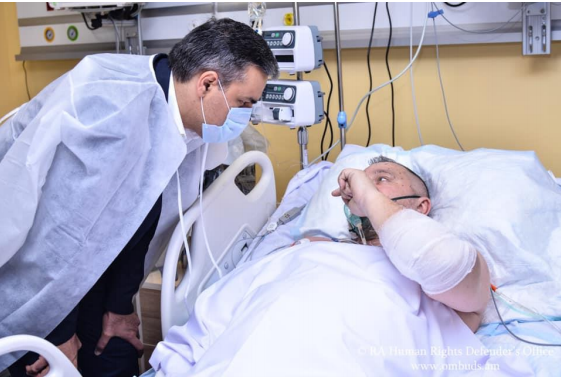
The journalist himself stated that he had personally witnessed the fact that there were absolutely no military objects on the way to Shushi. According to the ad hoc report of the Human Rights Defender of Armenia on the “Targeting Journalists Covering Hostilities in Artsakh”, the targeted nature of the shelling, including those against journalists were also proven by the facts that the journalists wore a special uniform and distinctive signs. The journalistic car that came under the shelling also had the “PRESS” distinctive sign.
Moreover, the journalists were targeted when they were carrying out their professional activities in civilian settlements, and not in the hotspots of hostilities. It should be also emphasized, that before the airstrikes, there was a journalistic video material posted
and disseminated on the internet, which explicitly showed that there are children, women, and elderly in the basement of the Cathedral.
Additionally, right after the first Azerbaijani airstrike on the Cathedral, there was information largely
disseminated, including photo and video materials, on peaceful residents being located in the
basement. Despite this, the Azerbaijani forces hit the Cathedral for the second time shortly after the
first strike.
The results of destruction caused to the St. Holy Savior Ghazanchetsots Cathedral by the Azerbaijani
airstrikes are huge.
Figure 19: The damaged roof of the St. Holy Savior Ghazanchetsots Cathedral from outside after the
second strike

Figure 21: The damaged roof of the St. Holy Savior Ghazanchetsots Cathedral from outside after the second strike
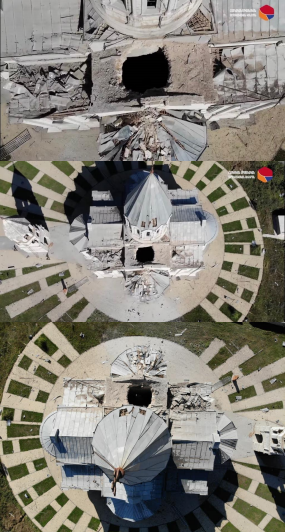
Figure 20: The damaged roof of the St. Holy Savior Ghazanchetsots Cathedral from outside after the second strike
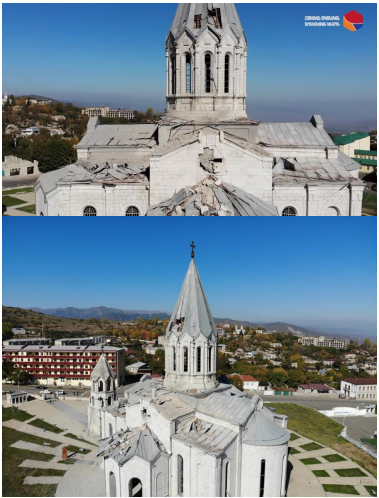
Figure 22: The damaged roof of the St. Holy Savior Ghazanchetsots Cathedral from inside after the second strike
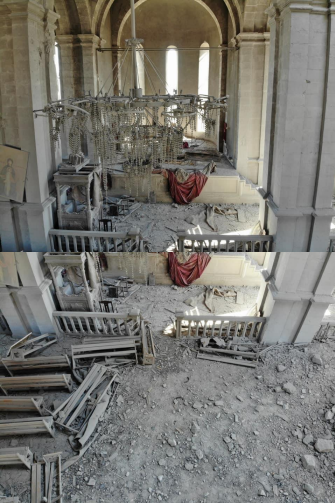
The aforementioned clearly shows that the Azerbaijani missiles were launched with the criminal intent to deprive the sheltered children, women, and elderly of their lives and to cause destruction of the Cathedral. It should be once again underlined, that Shushi is the second largest city of Artsakh, densely populated: it is a peaceful residential site. The St. Holy Savior Ghazanchetsots Cathedral is located in the center of the city, and there is no military object nearby. The aforementioned explicitly witnesses as to the Azerbaijani criminal intent to destroy the Armenian historical exceptional cultural heritage, humiliate Armenians by taking away its past, culture, and heritage, and kill peaceful residents and international journalists performing their
professional duties.
During the past few decades, culture has moved to the frontline of war, both as collateral damage and as a target for belligerents who use its destruction to foster violence, hatred, and vengeance. This destruction strikes at societies over the long term, weakening the foundations of peace and hindering reconciliation when hostilities end. Recent conflicts have demonstrated that the protection of heritage is inseparable from the protection of human lives. The destruction of heritage has become an integral part of a global strategy of cultural cleansing which seeks to eliminate all forms of diversity.
The policy of ethnic cleansing of Armenians and state-supported Armenophobia by Azerbaijan was emphasized in various publications, including in the Artsakh Ombudsman interim public report on Armenophobia in Azerbaijan Organized Hate Speech Animosity Towards Armenians. The ethnic cleansing is not only the atrocities against civilians and inhuman treatment of soldiers, as well as state-supported hatred towards Armenians, but also destruction and violence against the cultural and religious heritage. Further, the use of aerial bombing and long-distance weapons by Azerbaijan has made the destruction of cultural property more devastating.
The deliberate destruction of the St. Holy Savior Ghazanchetsots Cathedral is an example of the policy adopted by Azerbaijan aimed at eradication of the Armenian religious heritage. The rules for the protection of cultural heritage are found in several multilateral treaties and in customary international law.
The centerpiece of the relevant treaty-law is the Hague Convention for the Protection of Cultural Property in the Event of Armed Conflict (1954 Hague Convention)10, the Regulations for the Execution of the Convention, concluded in 1954, and the two protocols. The 1954 Hague Convention was accepted by Azerbaijan on 20 September, 1993.
The First Protocol was accepted by Azerbaijan on the same date as the 1954 Hague Convention, and the Second Protocol was ratified on 17 April 2001. Together these three treaties provide a detailed international legal framework for the protection of cultural property during armed conflict, including belligerent occupation. Article 1 of the 1954 Hague Convention defining the term “cultural heritage” states that,
“For the purposes of the present Convention, the term cultural property' shall cover, irrespective of origin or ownership: (a) movable or immovable property of great importance to the cultural heritage of every people, such as monuments of architecture, art or history, whether religious or secular; archaeological sites; groups of buildings which, as a whole, are of historical or artistic interest; works of art; manuscripts, books and other objects of artistic, historical or archaeological interest; as well as scientific collections and important collections of books or archives or of reproductions of the property defined above; (b) buildings whose main and effective purpose is to preserve or exhibit the movable cultural property defined in sub-paragraph (a) such as museums, large libraries and depositories of archives, and refuges intended to shelter, in the event of armed conflict, the movable cultural property defined in sub-paragraph (a); (c) centers containing a large amount of cultural property as defined in sub-paragraphs (a) and (b), to be known ascenters containing monuments’.”
Therefore, the term “cultural heritage” covers also religious buildings, such as churches and cathedrals. The general rule is that any attack against the cultural property during the hostilities is prohibited unless it becomes a military objective and there is no feasible alternative for obtaining a similar military advantage. Furthermore, Article 4 Paragraph 1 of the 1954 Hague Convention states that The High Contracting Parties undertake to respect cultural property situated within their own territory as well as within the territory of other High Contracting Parties by refraining from any use of the property and its immediate surroundings or of the appliances in use for its protection for purposes which are likely to expose it to destruction or damage in the event of armed conflict; and by refraining from any act of hostility, directed against such property. Brief provisions on the protection of cultural property in armed conflict can be found in Article 53 of the Protocol Additional to the Geneva Conventions of 12 August 1949, and relating to the Victims of International Armed Conflicts 1977 (Additional Protocol I) and in Article 16 of the Protocol Additional to the Geneva Conventions of 12 August 1949, and relating to the Victims of NonInternational Armed Conflicts 1977 (Additional Protocol II). Taking into account the high importance of the St. Holy Savior Ghazanchetsots Cathedral for all ethnic Armenians living both in Artsakh (Nagorno Karabakh) and outside, it should be considered as a cultural, religious heritage. Meantime, it should be also noted that the Cathedral was not used as a military object. Hence, its protection, being comprised of the safeguarding and
respecting must be properly ensured.
The number of destructions and damages caused to the cultural heritages during the armed conflicts
lead to the prescription of international rules on criminalizing the intentionally directing attacks
against the respective buildings. The aim is obvious, to prevent further destructions of essential values
of people.
Article 8 of the Rome Statute of the International Criminal Court states the War Crimes. According to Paragraph 2 Subparagraph (b) Point (ix) and Paragraph 2 Subparagraph (e) Point (iv), Intentionally directing attacks against buildings dedicated to religion, education, art, science or charitable purposes, historic monuments, hospitals, and places where the sick and wounded are
collected, provided they are not military objectives, is considered a War Crime.
In other instances, Article 8 Paragraph 2 Subparagraph (b) Point (xiii) can be also applied. In
particular, it states that “Destroying or seizing the enemy’s property unless such destruction or seizure
be imperatively demanded by the necessities of war.”
The intentional destruction of cultural property on discriminatory grounds can also constitute the crime
against humanity of persecution when it is committed as part of a widespread or systematic attack
against a civilian population.
Both the International Criminal Court (ICC) and the International Criminal Tribunal for the former
Yugoslavia (ICTY) convicted perpetrators for the destruction of cultural property. In those cases, the
destruction of cultural property was qualified as both a war crime and a crime against humanity.
In the case of the Prosecutor v. Ahmad Al Faqi Al Mahdi, the Trial Chamber VIII unanimously found Mr
Al Mahdi guilty, as a co-perpetrator, of the war crime of intentionally directing attacks against
historic monuments and buildings dedicated to religion.
In number of cases of the ICTY the perpetrators were charged for the destruction of historical and
religious buildings and other heritages.
It should be once again noted that the St. Holy Savior Ghazanchetsots Cathedral, as a cultural property
is of high importance for all ethnic Armenians and in the period of the Azerbaijani attacks on 8
October was not used for military purposes.
Taking into account, that the St. Holy Savior Ghazanchetsots Cathedral is both a religious and
historic building, the intentional attack on and destruction of the Cathedral can be considered as
a war crime and crime against humanity. Moreover, the deliberate strikes on the religious
heritage St. Holy Savior Ghazanchetsots Cathedral cannot be considered necessary, in case
when it is used solely as a refuge for a peaceful population, children, and women.
The above article is based on the report published by Human Rights Ombudsman Of The Republic Of Artsakh, on October 20, 2020, which can be downloaded here.

